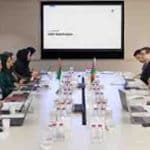BEIJING, June. 2 (APP): China’s leading solar solutions provider LONGi officially released the sixth annual corporate sustainability report for 2022 in Beijing, providing an elaborate summary of its practices and achievements in the field of environment, society and governance (ESG) in the past year.
Pakistan, as an indispensable international market for LONGi, is poised to show more competitiveness in the global PV market. “Since 2020, LONGi Solar has successfully exported more than 1GW of solar panels to the Pakistani market, as a momentous milestone,” Ali Majid, General Manager, Pakistan, LONGi Solar, said in an interview.
As Pakistan is one of the most vulnerable countries to the adverse impact of increasingly severe climate change, sustainable development has become a pressing issue in the country.
Photovoltaic power generation, as the best choice to solve Pakistan’s power shortage and optimize its energy structure to a great extent based on fossil fuels, while saving foreign exchange required for energy imports, has vast potential for future development, CEN reported on Friday.
From 2012 to 2022, LONGi produced a total of 290GW of photovoltaic products, with the cumulative output of clean electricity exceeded 1,148,287 GWh.
According to the International Energy Agency’s global power grid average emission factor, it is equivalent to avoiding 536 million tons of carbon dioxide emissions. As for Pakistani market, both distributed and centralized PV products have market segment demand, distributed PV systems, such as rooftop solar installations on residential, commercial, and industrial buildings, have been gaining popularity in Pakistan.
Net metering policies and incentives have been introduced to promote distributed generation and allow consumers to offset their electricity bills by exporting excess power back to the grid, Majid mentioned.
“At the same time, our government has been focusing on the development of large-scale centralized PV projects, including solar parks and utility-scale solar installations,” he added, “these centralized PV systems contribute to the overall renewable energy capacity of the country and help diversify the energy mix.”
Currently, both local and international players are competing to capture a share of Pakistan, a burgeoning PV market. In 2022, China’s photovoltaic module exports to Pakistan reached approximately USD 870 million, with a total installed capacity of 3.2GW, a year-on-year increase of 54 percent and 37 percent, respectively, according to the statistics of China Photovoltaic Industry Association (CPIA).
On the other hand, for Pakistan itself, in order to maximize the development of sustainable industries such as photovoltaics, it is imperative to solve problems such as the foreign exchange gap. A large foreign exchange gap can put pressure on the country’s ability to finance its imports, including PV products, and may necessitate measures such as foreign exchange controls, import restrictions, or adjustments to import tariffs, Majid told the reporter.
“Currency fluctuations, for example, can affect the pricing of imported PV products. Thus, a stable economic environment, the basis for ensuring the smooth development of such a sustainable industry, needs the joint efforts of the government, industry and enterprises ourselves,” Majid noted that if Pakistan hopes to truly carve out a niche in the global photovoltaic market with unique competitiveness, the resultant force of the three are indispensable.
Energy is one of the areas where CPEC has invested the most, progressed the fastest, and achieved the most remarkable results. “The global photovoltaic industry is developing in full swing. China-Pakistan cooperation in related industries can make due contributions to the global response to climate change,” Majid concluded.
Follow the PNI Facebook page for the latest news and updates.








